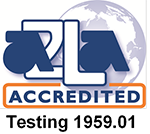Physical testing on new materials that feed our new product pipeline is completed in our A2LA accredited laboratory. Our scope includes a wide range of well-known test methods as well as tests developed by Lydall’s research team. The material testing approach is capped by several part based test methods, which allow DV and PV testing to be completed in a manner representative of the application. During our typical product development phase, material and part testing activities are wound around a long series of numerical simulations. Initial heat flux balance numerical models quickly predict the thermal responses of our products. These are later refined with FE analyses that provide a more clear view of the application. Our approach to thermal analysis and the clear representation of results is unique and renders evident design and material changes. Thermal analyses juxtaposed with modal and harmonic simulations to ensure the solution is mechanically robust.
The testing and simulation activities are located around the world to ensure local customer support with a global a view.
Numerical Simulation
- CFD Thermal Analysis
- Modal Analysis
- Stress Response
Thermal Testing
- Natural gas burner system for full exhaust and exhaust sub-system testing. Dynamic testing of manifolds, catalytic converters, and mufflers to find the correct thermal solution to meet your needs.
- Electric heater system for small-scale quick turn simulation and measurement.
- Thermocouple measurements and infrared (IR) technology are used to measure and evaluate the thermal environment.
Acoustic Testing
- Head and torso for in-vehicle sound pressure measurement
- Normal incidence sound absorption measurement - impedance tube
- Random incidence sound absorption measurement - alpha cabin
Vibration/Durability Testing
- Single axis electrodynamic shaker systems for long term durability and multi-channel acquisition for modal analysis
- Durability tests are simulated in-house to provide critical knowledge of the life expectancy of parts and Customer Equivalent Mileage (CEM) correlation and can be run at elevated temperatures to properly represent the application environment.
Physical/Mechanical Testing and Component Validation
 |
|
